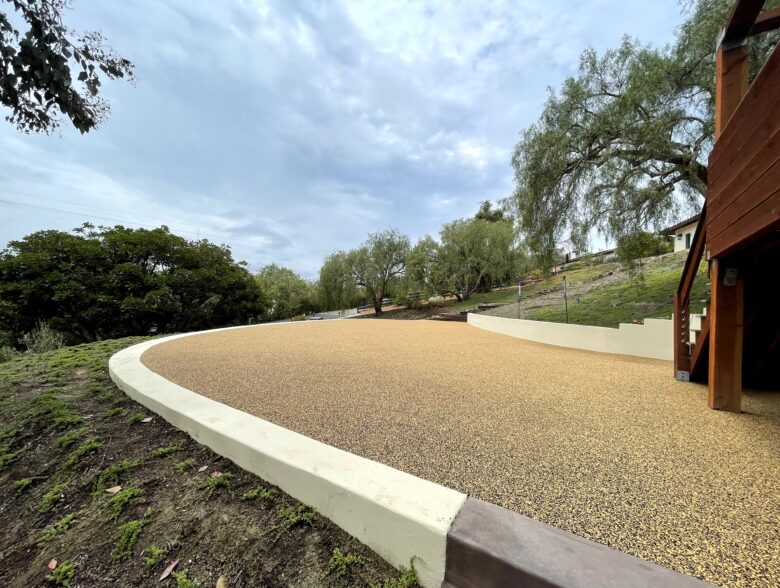Rubber Sidewalks, Walkways, And Paths In San Diego
Playground Safety Surfacing rubber sidewalks are a porous, flexible, and environmentally friendly alternative to concrete, asphalt, and prefabricated pavers. These rubber sidewalks, made from recycled rubber from post-consumer tires, can resist heavy rain and provide quick drainage, making them the ideal stormwater management option for green city infrastructure.
Rubber sidewalks are a low-impact development technique that communities are adopting.
Poured In Place rubber sidewalks have been placed across the United States for almost two decades and have gone through extensive testing to verify their durability, long life, and cost-effectiveness. Poured In Place’s pricing, installation, maintenance, specifications, and testing are compared against rubber pavers, concrete, and asphalt in our Competitive Analysis.
Rubber Sidewalks: A Sustainable Solution To Cracked Sidewalks
City and public works agencies are continuously faced with public safety problems and financial constraints posed by cracked and broken sidewalks caused by tree roots, freeze-thaw, and automobile traffic.
Because of their flexibility and porous nature, rubber sidewalks are an excellent alternative for cracked sidewalks.
Rubber sidewalks will stretch as tree roots develop rather than crack due to root heave, a major problem with standard concrete sidewalks. Our porosity also lets water enter the subsurface, where it nourishes tree roots below ground, promoting deep rooting, decreasing cracking and heaving, and lowering the likelihood of trees blowing over in high wind gusts. Our rubber sidewalks can even be put directly over tree roots without causing damage or obstructing the tree’s growth.
What Is Rubber Sidewalk?
Poured In Place is a proprietary, poured-in-place method that uses post-consumer recycled tires to create a contemporary, ecologically friendly sidewalk option. This porous rubber sidewalk system is color and designs changeable, and it can be laid on slopes, across mounds, and around bends with ease.
Our rubber sidewalk system is made up of two layers: a base layer made entirely of recycled crumb rubber and a “wear” layer made entirely of long-lasting, fade-resistant virgin colored rubber (EPDM).
The rubber granules are tiny and compress nicely. However, they drain quickly. Each layer’s rubber granules are blended in a certain ratio with our proprietary binders, then troweled uniformly to a defined thickness.
We can be laid on top of concrete, asphalt, or a layer of compacted/crushed miscellaneous base (CMB). The system will become non-porous if concrete or asphalt is used as a sub-base, but it will retain the other characteristics of rubber sidewalks, such as flexibility, resilience, and safety.
Region-specific sub-base needs should be adjusted accordingly. Please contact us with the specifics of your project, and we will assist you in obtaining the appropriate requirements.
Rubber Sidewalk Leed Green Building Credits
Our Sidewalks and other systems may earn LEED points in a variety of ways, including:
1) HEAT ISLAND EFFECT- LEED CREDIT SSC7.1 (2 POINTS POSSIBLE)
This credit is for items that influence solar reflectance, thermal emittance, permeability, and tree maintenance to help reduce the “heat island effect.” Poured In Place satisfies the following criteria:
Our Sidewalks are permeable, allowing water to penetrate and rinse while reducing run-off issues. 75 gal/min/yd2 Our Sidewalk Drains
Lighter hues have more reflectivity, which means they absorb less heat. Our Sidewalks in light gray and beige have an SRI of 31 and a reflectivity of 42.
Surface Thermal Emittance: Lighter colors lower surface thermal emittance. The thermal emittance of Poured In Place Sidewalks in light gray and beige is 0.83.
Our Sidewalks are porous and flexible, enabling water to penetrate to prevent root heave caused by water deprivation, which often leads to tree loss due to broken sidewalks and public safety concerns. Our Sidewalks allow urban trees to remain in situ, providing shade, moisture retention, and lowering the urban heat island effect.
2) RECYCLED CONTENT- LEED CREDIT MRC4 (2 POINTS POSSIBLE)
Our systems employ 100 percent recycled tires when all black crumb rubber is used. When a colored EPDM virgin rubber wear layer is added, the recycled content without the binder ranges from 66 to 100%.
3) REGIONAL MATERIALS- LEED CREDIT MRC5 (2 POINTS POSSIBLE)
Our systems in California are made entirely of materials that are manufactured or produced in the state. Wherever feasible, we use regional materials in the United States.
4) STORM WATER DESIGN- LEED CREDITS SSC6.1 AND SSC6.2 (2 POINTS POSSIBLE)
Rain and other sources of water can penetrate the subsurface using Poured In Place pervious paving systems, minimizing stormwater runoff.
5) INNOVATION IN DESIGN- LEED CREDIT IDC1 (5 POINTS POSSIBLE)
We have an innovative green building technology that uses recycled tires to create a permeable, robust, colorful, appealing, and durable surfacing solution. The system is seamless, which prevents warping, curling, and dislodging; nonlinear, which allows it to follow curves, travel around corners, and accept contour changes; and robust, which provides safe, pleasant traction, lowering liability damages from slipping or falling.
Below you will find specifications, detailed drawings, and brochures.
For assistance in making your project a success, please contact us.
Our Services
GET MORE INFORMATION
Fill out the next form and send it directly to Playground Safety Surfacing inbox, as soon as possible we will reply your mail or call you back.
For more information you can also contact us by the following telephone numbers:
(888) 902-3777 San Diego & Surrounding Areas.

